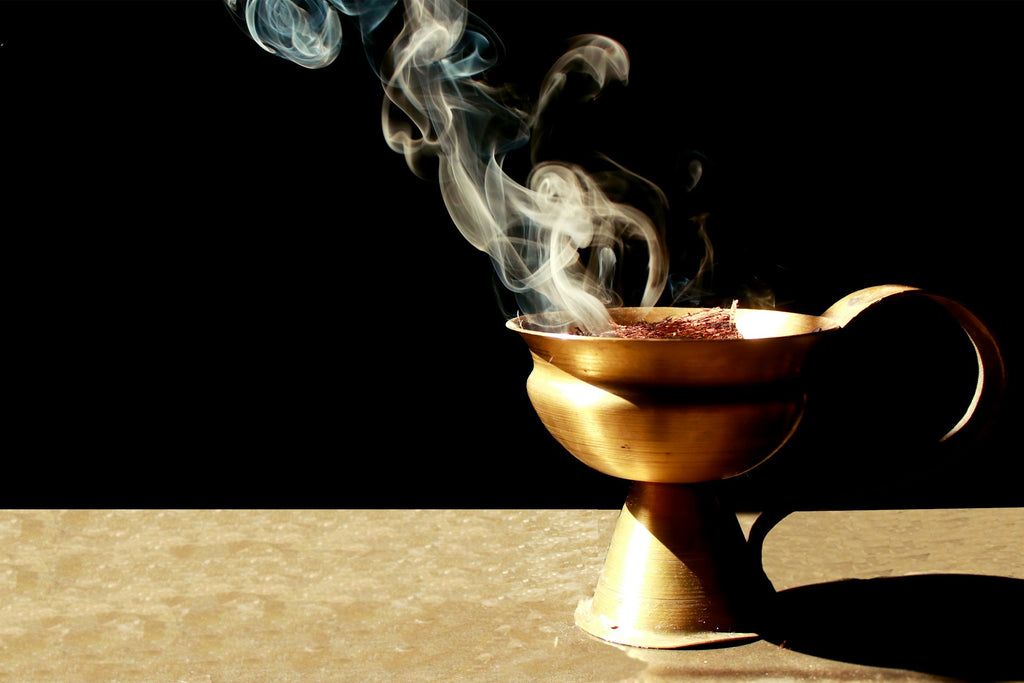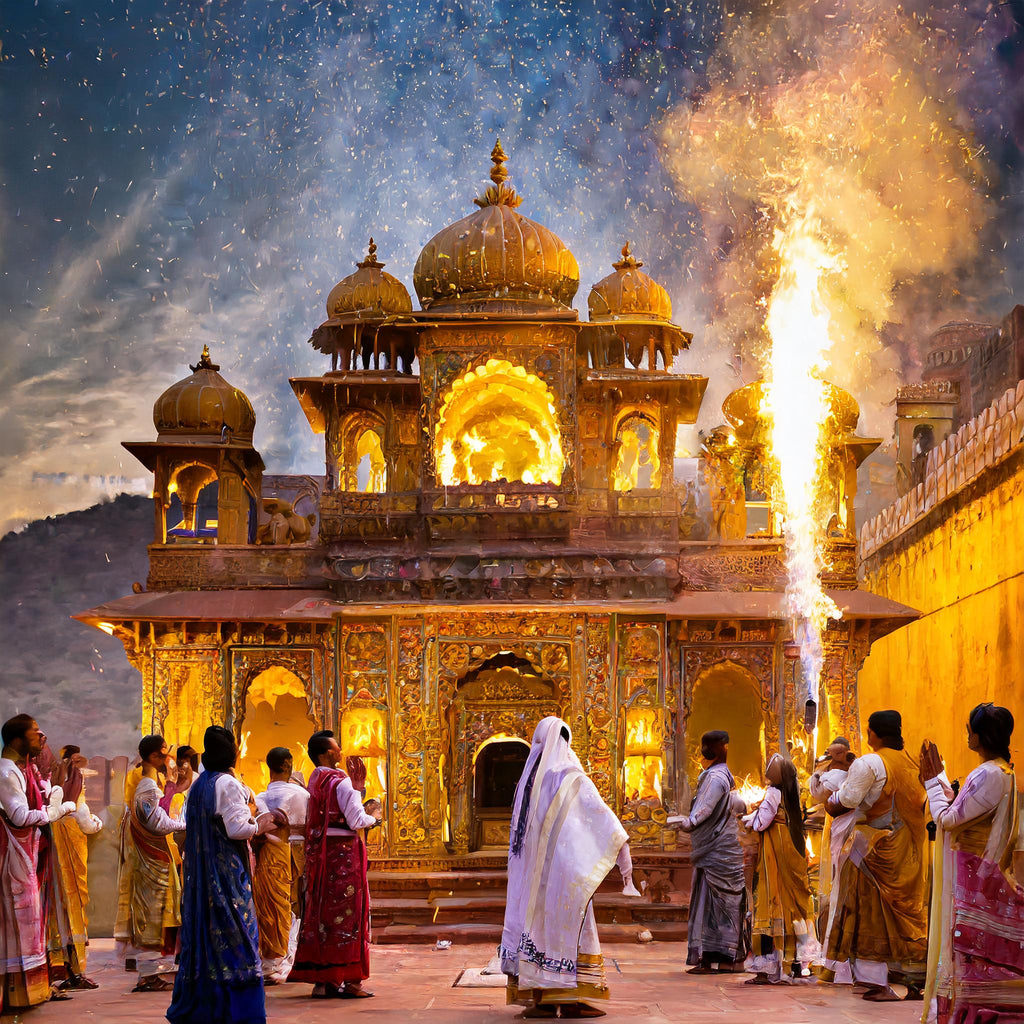
Agarwood in Various Religions
Agarwood in Various Religions - Hinduism, Christianity, Buddhism and Islam

(Photo Credit : Sayak Bala)
Agarwood is highly revered in the seminal texts of Hinduism, Christianity, Buddhism, and Islam
Aromatics and spices have been synonymous with wealth, exclusivity, and luxury, although elites could justify their use as necessary owing to their religious, funerary, medical, and culinary importance (Cobb 2013).
Frankincense and myrrh are well-known examples of fragrant resin highly demanded and valued by the people of ancient Egypt, Mesopotamia, Greece, Rome, China, and India.
The earliest recorded use of plant aromatics is found in the four Vedas of ancient India. These texts are proto Hindu, written between 1500–1000 B.C.E., and include descriptions of the already sophisticated use of aromatics.
The spiritual significance of aromatic plants was highlighted in these ancient texts and was often referred to as the “Spirit of life” (Prâna) (Bloomfield 1897:218) and used as a fragrant smoke for spiritual connections with heaven and as offerings during divine worship (Hymn II. Agni.)
Agarwood in Hindu Texts
The Sanskrit epic narrative Mahābhārata (describing the period 1493–1443 B.C.E. of Indian history [Iyengar 2003]) contains the description of the use of fragrance in the context of human pleasure, luxury, and well-being (Rhind 2014).

Agarwood was often identified in the text as a display of wealth, a tribute, and a greeting. In the first book of Mahābhārata, the people of the ancient city of Khandavaprastha received distant visitors (Madhava and other tribes) by filling every part of the town “with the sweet scent of burning agarwood.”
Also in Book 1, the use of agarwood for displaying status and wealth was detailed in the description of an amphitheater on the outskirts of King Drupada’s capital (Kamapilya), which was “enclosed on all sides with high walls and a moat (and) scented with black agarwood and sprinkled all over with water mixed with sandal paste and decorated with garlands of flowers”.
The mansions that surrounded this amphitheater were also “rendered fragrant with excellent agarwood,” and the “exalted sovereigns” that inhabited the mansions were “possessed with the desire of excelling one another” and “all adorned with the fragrant paste of the black agarwood”
The second book contains a detailed description of the mansions of monarchs, which “hung over with garlands of flowers and perfumed with excellent agarwood”
It also details that after the Bharatas people conquered the Mlechchha tribes, the vanquished were made to pay tributes of a great many valuable items including fragrant goods of sandalwood and agarwood.
In the Vedas, agarwood is listed among nature’s eight sought-after fragrant bounties —
“Agar tagar chandan yugal, kesar aur kapoor
Gaurochan aur mrigmida, ashtagandh bharpoor”
Translation : Agar: oud or agarwood; tagar: turmeric-like fragrant root; chandan yugal: sandalwood pair, namely red and white sandalwood, the latter being more fragrant; kesar: saffron; kapoor: camphor; gaurochan; cow spleen; mrigmida: musk; ashtagandha bharpoor: the ashtagandha through all eight materials, becomes complete and whole.
The refined use of agarwood and many other aromatics in this text indicates a long association with and veneration for fragrant products.
Agarwood in Christian Scriptures
Agarwood is referenced several times in the Old Testament of the Christian Bible, firstly where Balaam describes God’s vision of Israel and likens their settlements as being “like agarwood planted by the LORD” (Numbers 24:6).

Also in the Old Testament, the noble and seductive importance of agarwood is presented in Psalm 45:8 where, recounting a king’s preparation for marriage, it states that “All your robes are fragrant with myrrh and agarwood and cassia.”
The seductive power of aromatics including agarwood is further described in Song of Songs 4:14 rejoicing the sexual attraction between two lovers, where one praises the other “Your plants are an orchard of every kind of incense tree, with myrrh and agarwood and all the finest spices.”
Agarwood in Buddhist Texts
In several Buddhists texts, there are references to the use of aromatics in religious rituals.
For instance, in the Jātaka tales, which are extensive literary works about the Buddha Birth stories (~ 4th century B.C.E.) (Pierce 1969), agarwood is mentioned in Vol VI no. 542.
Both agarwood and sandalwood, in combination with other valuable items, were used as a mark of respect and were already being used as valuable fragrant products during ancient times.

In the Mahāyāna Mahāparinirvāṇa Sūtra (Nirvana Sutra), the use of aromatics is mentioned in the introductory chapter. In one description, the use of fragrant wood in the cremation of Tathāgata’s (Buddha) body is mentioned, “people each held in their hands tens of thousands of bundles of such fragrant wood as sandalwood, agarwood, goirsa sandalwood, and heavenly wood.”
Agarwood was also used as fuel in stoves to prepare meals for the Buddha and the Sangha (monks).
In poem 35 (7), The Seventh: Sesavati’s Mansion (Sesavatīvimāna), during the funeral ceremony of the venerable Captain of Dhamma (Sāriputta), agarwood, sandalwood, and similar woods were used as a part of the pyre of a hundred cubits high (Ireland 2005).
Bazin (2013) suggested that five natural incense products represented the speech of the five buddhas and included sandalwood, agarwood, pine resin or juniper, camphor, and vetiver root.
Agarwood in Islamic Texts
In several Hadith (reports of the words, actions, or tacit approval of the prophet Muḥammad, agarwood is referred to as a type of Indian incense (i.e., Ūd Al- Hindi or agarwood).
Allah’s Messenger was quoted (by Abu Huraira) describing Paradise where, among many wondrous things, agarwood would be used in their censers (incense burner) (Sahih al-Bukhari 3327, Book 60, Hadith 2)
The use of agarwood as a medical treatment was recommended by the prophet Muhammad and was said to contain seven types of remedies, including one for a swollen uvula and another for pleurisy (Sahih al-Bukhari 5692, 5693, Book 76, Hadith 15; USC-MSA English reference Sahih al-Bukhari Vol. 7, Book 71, Hadith 596, 613; Sunan Abi Dawud 3877, Book 29, Hadith 23; English translation Book 28, Hadith 3868).

Agarwood was also cited as relieving common ailments, and the Prophet said, concerning a Muhrim (pilgrim) whose head or eyes hurt: Let him smudge them with agarwood (Sunan an-Nasa’i 2711, Book 24, Hadith 0; English translation Vol. 3, Book 24, Hadith 2712).
Agarwood was used in the important practice of fumigation/ purification where Nafi’ reports on Ibn Umar fumigating with agarwood either by itself or mixed with camphor (Sahih Muslim 2254 Book 40, Hadith 23; English translation Book 27, Hadith 5601).
It is known that the prophet Muhammad preferred the scent of agarwood or a combination of agarwood and camphor (Book 27 no. 5601) (Sahih Muslim n.d.).
The burning of incense in a mosque was practiced by Umar the second caliph, which led to the practice becoming commonplace. There is no record of what was burnt, but it is believed that it was agarwood by itself or combined with camphor (Ergin 2014).
Reference :
History of Use and Trade of Agarwood
Arlene Lopez-Sampson and Tony Page
Leave a comment
Also in Historical Accounts of Oud

The Story of Aloeswood of Ubayd-Allah | A Short Anecdote from History

Legendary Aloeswood from India | A Short-Story From 9th Century CE




Yawar Saeed
Author
The visionary founder behind Indicana Oud, your premier destination for authentic oud products. With a deep-rooted love for oud and a commitment to authenticity, Yawar's mission goes beyond business; he seeks to enlighten and educate others about the multifaceted aspects of agarwood